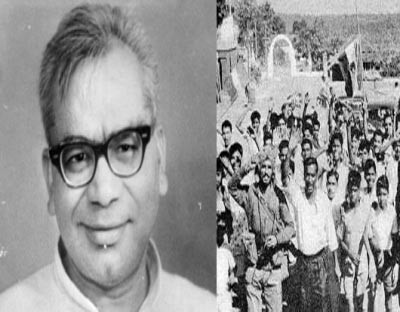
Panaji, One could say that the seeds of revolution, which eventually freed Goa from 451 years of Portuguese colonial rule were sown in Berlin in the 1920s.
Ram Manohar Lohia, a young man from Akbarpur in Uttar Pradesh was grinding out a doctoral thesis on salt taxation in India at Berlin's Frederick William University, while another youngster Juliao Menezes from Goa was studying medicine in the same city, far away from his native village of Assolna, which is incidentally also known for its traditional salt pan industry.
They grew from strangers to acquaintances to friends and years later ended up shouldering the responsibility of kickstarting a civil disobedience movement on June 18, 1946, which history now refers to as Goa Revolution Day.
Lohia had other plans when he arrived in Goa on June 10, soon after his release from a British prison in Lahore. He was ill and Menezes had urged him to visit Goa to help the already well known freedom fighter to recuperate.
Lohia's presence in Goa however ended up putting the Portuguese-held colony on the path of recovery from the colonial curse.
While in Goa, Lohia understood the plight of the natives under the dictatorial regime of Portuguese Prime Minister Antonio Salazar. Lohia's response was to inspire a non-violent civil disobedience movement - the first such in Goa -- at the central square in Margao town in South Goa on June 18, 1946.
"You (people of Goa) cannot form organisations. Not to talk of political organisations like Indian National Congress, even organisations, for study or sports or village uplift, require previous sanctions of the government and must obviously work under police watch. You cannot hold meetings not to talk of political meetings, even social and private gatherings, require permissions and come in for police inquiry," Lohia said in his iconic speech on the day.
When a group of freedom fighters tried to garland Lohia, a Portuguese captain even pulled out a revolver and levelled the weapon at them, before Lohia did the unthinkable.
"At this sight Capt Miranda with his Latin blood and excitement straight took out his revolver and pointed it gallantly at the unarmed civilian Goans who were approaching us with garlands in their hands. Lohia, at this moment acted quickly. He caught hold of the hand of the brave captain in which the weapon was held, ordered him to be calm, brushed him aside, calmly proceeded to the place of meeting and started to address the people," Menezes writes in his book 'Goa Freedom Struggle'.
Lohia's torching of the civil disobedience spirit in Goa, earned both him and Menezes a spell in incarceration at the Aguada prison.
"There were just two rooms at the end of a dark line of barracks at the Fortaleza da Aguada (Aguada prison) which faced the sea. Lohia was in one and one of Goa's most well-known thinkers and freedom fighters TB Cunha was in another. They were both in solitary confinement," says freedom fighter Naguesh Karmali, who was himself arrested in course of the freedom struggle.
After several days in solitary confinement, Lohia was released from prison and deported to British India.
Lohia's brief stint in Goa inspired the resistance movement and his stint at the Aguada prison also earned him the title of 'The Lion of Aguada' from noted Goan poet Manohar Rai Sardesai.
As a homage to Lohia, his life-size statue will be installed in the Aguada jail complex, which is being refurbished on the lines of the Cellular jail complex, where freedom fighter Veer Savarkar was imprisoned in the Andaman islands.


.jpeg)

